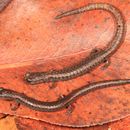Description
provided by AmphibiaWeb articles
The smallest member of the genus, Batrachoseps minor is still relatively robust compared to neighbors B. gavilanensis and B. nigriventris. It can be distinguished from other members of the genus by its small size at sexual maturity. The head is relatively broad, and there is a distinct neck region. The face is small and inconspicuous, and the eyes are slightly protuberant. While small in length, it has relatively long limbs and large four-toed hands and feet. There are usually 18-19 (male) or 19 (female) trunk vertebrae, and 5-8 costal folds between adpressed limbs. Species has a dark blackish-brown color with flanks especially being the darkest part of the body. Many individuals have a prominent dorsal band much lighter than the rest of the body.Throughout its entire distribution, the species is microsympatric with B. nigriventis although it is somewhat more robust than this relative. This species was common locally about 20 years ago but in the past 10 years it has been almost impossible to find. A single specimen was found in the spring of 2000 following diligent searches by several experienced herpetologists over the course of several years. It is difficult to understand factors in its decline, but in the immediate vicinity of the York Mountain Vinyards and Winery, where it was once abundant, modernization and expansion has eliminated some habitat. See another account at californiaherps.com (http://www.californiaherps.com/salamanders/pages/b.minor.html).
Distribution and Habitat
provided by AmphibiaWeb articles
The species is endemic to California and is restricted to the southern Santa Lucia Range of north-central San Luis Obispo County. In the north, it occurs immediately north of Black Mountain, and it ranges south and east into the drainages of Paso Robles and Santa Rita creeks. The type locality is a mesic canyon surrounded by relatively more xeric habitats. It was often found in shaded areas with abundant leaf litter. Trees include tanbark oak, coast live oak, blue oak, sycamore, and laurel, and abundant lower story vegetation dominated by poison oak. Species seems to be restricted to higher elevations and mesic regions.
Life History, Abundance, Activity, and Special Behaviors
provided by AmphibiaWeb articles
B. minor has become noticeably less common in recent years.
Lesser slender salamander: Brief Summary
provided by wikipedia EN
The lesser slender salamander (Batrachoseps minor) is a species of salamander in the family Plethodontidae.
- license
- cc-by-sa-3.0
- copyright
- Wikipedia authors and editors

